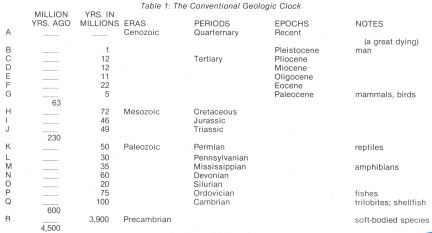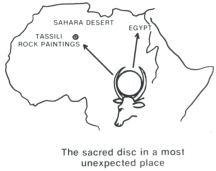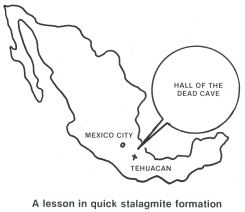
|
|
|
|
Introduction. This book focuses primarily on people's beliefs about time - time as presented from scientific sources versus time as indicated in the Scriptures. Is textbook time vulnerable? Can one break down textbook time concepts? If the answer is 'Yes,' a great deal will have been accomplished. The reader is invited to consider a wide range of evidence.
In the following pages we find to our astonishment that the real world is very unlike the one described in many texts: Geographic features of apparent great age can develop almost overnight. The layers of rocks in many parts of the world are not in the order they ought to be if evolutionary assumptions and development are correct. Scientific dating has very serious problems and shortcomings. Measurement of the strength of the earth's magnetic field strongly indicates a very young earth. Animals have been found long before or long after they were supposed to exist according to evolutionary theory. Human artifacts have been found in rocks or strata considered much older than man. Animal and human footprints have been found in 'impossible' places. Fossil remains of man are found in locations and under circumstances which cast great doubt on conventional dating and the assumption that man developed from a primitive or animal existence to a sophisticated level.

It is important to become at least modestly acquainted with the conventional geologic clock. It originated long before any real scientific approach was possible. It was carefully developed in the early nineteenth century according to uniformitarian assumptions. Vast ages were simply assumed by this approach. The tendency has been to lengthen the periods from time to time, not on the basis of scientific dating, but rather to give evolutionary principles more and more time to bring about changes required by that theory.
The following presents much food for thought, along with the suspicion
that things are not always what they seem.
Seventy kilometers south of Iceland a new island was born in 1963. This
in itself is not an unusual occurrence. The following year, Sigurdur Thorarinsson
(1964), Iceland's foremost geophysicist, wrote a little book about the
island. Here is part of his description of the new island:
Only a few months have sufficed for a landscape to be created which is so varied and mature that it is almost beyond belief...Here we see wide sandy beaches and precipitous crags lashed by breakers of the sea. There are gravel banks and lagoons, impressive cliffs resembling the White Cliffs on the English Channel. There are hollows, glens, and soft undulating land. There are fractures and faulted cliffs, channels and rock debris. There are boulders worn by the surf, some of which are almost round, and further out there is a sandy beach where you can walk at low tide without getting wet.

Dr. Thorarinsson comments as follows, and we must remember that the
island is now just one year old.
An Icelander who has studied geology and geomorphology
at foreign universities is later taught by experience in his own homeland
that the time scale he had been trained to attach to geological development
is misleading...What elsewhere may take thousands of years may be accomplished
here in one century. All the same he is amazed whenever he goes to Surtsey,
because there the same development may take a few weeks or even a few days.

There are surprises elsewhere. Evidence was submitted by scientists
from Harvard and Carnegie Institute that the mighty Himalayas, during violent
upheavals, reached their present form and height in the age of man, in
historic times. Evidence for the same phenomenon has been noted regarding
the Andes, that in historic times the mountains rose many thousands of
feet (Velikovsky, 1955, p.286). If at least some mountains are very, very
young, what reason is there to believe that other mountains are untold
millions of years old?
 |
The ancients handed down some wild tales. One of these is the account of the travels of the Argonauts who sailed from the Mediterranean across the Sahara (including portages) all the way to the west coast of Africa. (de Santillana, 1969, p.255). To put it mildly, the tale makes no sense at all. The Piri Reis map fragments referred to above also include a large portion of the Sahara that shows a network |
| of lakes and rivers which could well have been navigable
in historic times (Hapgood, 1966). Some day we may have to take another
look seriously at this voyage of the Argonauts.
It has recently become known that abundant fresh water lies beneath enormous areas of the Sahara desert, enough probably to meet all human and animal needs several times over. |
 |
The location of the Sphinx strongly indicates that the Sahara was not a desert at the time the Sphinx was constructed. The base is repeatedly cleared, but the next wind storm covers it again (Tompkins, 1971, p.142).
 |
 |
In areas where even camels now turn away in despair, lush vegetation
grew in historic times. Most of the Sahara was a land of lakes and rivers
full of fish. There were meadows, forests, and fertile valleys offering
sustenance for a large human and animal population. It staggers the mind
to discover that fish harpoons have been found in many areas of the Sahara.
In remote regions, rock carvings and paintings exist by the tens of thousands.
Some of the cattle in these paintings wore discs between the horns as in
Egyptian paintings. Some rock drawings show Phoenician work or influence.
Pottery, tools, and polished stone weapons have been found in abundance.
The desert did not form gradually over long eons of time. It occurred suddenly
in historic times (Velikovsky, 1955, p.93; Scientific American ,
214 [May 1966], 21).
 |
Other kinds of evidence show the same kind of very rapid growth or development. When you take a tour through a cave, you have apparent evidence right before your eyes of stalagmites and stalactites that took many millions of years to form. Little specifically seems to be known about the growth rate, except that it is a vaguely slow process. Some formations are said to be about 100,000 years old since they rest on silt and fossils dated at about that age. The usual orthodox view is that only rarely will more than one hundredth of an inch be deposited per ten-year period, or one inch in a thousand years (Pensee 3:1, p.48; CRSQ , 8:2, p.144). |
Yet a writer in Nature some years ago was able to show that a stalagmite about 15 years old from a lead mine exactly paralleled in form and height another which in association with human remains had been estimated by experts as being 220,800 years old. Some authorities are suggesting that the association of human bones with long extinct animals may not be proof of the antiquity of man but rather that these animals lived into quite recent times. (Custance, 1968, p.20).
In a cave in England water passing through a lime deposit was led through
a four-inch pipe. In eight weeks the diameter was reduced to only one inch
and the crystallized deposit, which had grown in layers like tree rings,
gave every appearance of being thousands of years old (Victoria Institute
, 1879, 15:235). In New England spouts carrying water from mines become
choked up with deposits within two or three years. A stalactite a foot
long was found hanging under a railroad bridge in Alliance, Ohio.
Grown stalactites were found one year after the atomic explosion was
set off in Gnome Cavern, New Mexico. A five-inch stalactite was found in
the man-made Hetch Hetchy tunnel, California, less than 20 years after
it was built. Another one, eight inches long, was found hanging from a
flume in Georgia which formed in less than a century. There are numerous
reports of other quick-grow stalagmites: In the Carrara District, Italy,
stalagmitic deposits are a local source of income. The water is so impregnated
that any object placed in it is thickly coated in two weeks. About a hundred
miles from Zagreb, Jugoslavia, lakes fed by waters coming through limestone
beds are so charged that deposits are more in the hour range than the century.
Objects placed in these waters are soon coated by lime deposits (Victoria
Institute , 1872, 8:226-228; 1883, 19:200; CRSQ, 1970, 7:4,
p.243; 1971, 8:4, p.249; 1972, 9:3, p.197; Pensee, Fall 1972,2:3,
p.18).
| In a cave in the Tehuacan Valley of Mexico, a vast chamber known as the Hall of the Dead was found. A massive cave-in had occurred and one can still see the skeletons of people of the Olmec period there. The skeletons are all covered with stalagmites. Rather than an age in the millions of years, the skeletons are dated as no earlier than 1200 B.C. (Pensee , Winter 1973, 3:12, p.48). |  |
 |
 |
About twenty years ago the clear outline of a bat was found inside a stalagmitic deposit in Carlsbad Caverns, New Mexico. It had been cemented over before bacteria, decay, or predators could destroy it. The suggestion was made that under the right conditions the growth rate of the stalagmite might be amazingly rapid (CRSQ , 1971, 8:2, p.144).
Other kinds of rock may form very rapidly. The Popular Science News reported a find of quartz crystals in a Nevada mine which could have had only 15 years maximum in which to form. In the same area a mill had been torn down and the discovery was made that sandstone had formed during a twelve-year period. In the sandstone was a piece of wood with a nail in it (Fort, 1941, p.131).
In the British Museum there is a skeleton embedded in solid rock that
came from the island of Guadaloupe in the West Indies. The rock is a hard
limestone and also contains fragments of shells and coral. The skeleton
is that of an Indian killed in battle with the British only two centuries
ago (Victoria Institute , 1877, 13:36).
It was customary in the past to attribute great age to peat deposits.
Scientists taught that peat forms at the rate of about one-fifth inch per
century, or one foot in 6,000 years. More than a century ago, however,
peat farmers said that the rate was about 2 1/2 inches per year. That is
1250 times as fast as the scientists claimed. A large number of embarrassing
finds soon supported the experience of the peat farmers. In some places
in Scotland, old Roman roads were covered with peat in places to a depth
of eight feet, but one could hardly argue for an age of 48,000 years for
them. It is still true, however, that elephant bones found under a few
inches or feet of peat in America are dated in terms of many thousands
of years.(Victoria Institute , 1866, 2:325). They could be very
recent.
Other finds included datable metal objects found at great depths in
peat beds. In Abbeville, France, a boat loaded with Roman bricks was found
in the lowest tier of the peat. In the Somme Valley, beech stumps up to
four feet in height were found covered by peat before they had decayed
(Victoria Institute , 1877, 13:111-112).
| Drop by drop the water that bears a trace of minerals trickles
on the logs that had been buried in a storm. Millions of years pass. At
long last the process is completed. Today tourists look in awe at the Petrified
Forest in Arizona. Who can doubt the immense age of the earth?
However, more than a century ago, in the 1860s, a scientist asked how one would account for the fact that wood had turned to stone without injury to the most delicate vegetable fibers. If long periods of |
 |
Counter to commonly held beliefs and textbook teaching, a scientist in 1947 noted that logs had petrified in less than one year (Andrew, 1947, p.19).
In the 1870s, Dr. Scheuermann discovered a number of sticks, apparently
artifically pointed by the hand of man, that had been found in lignite.
The lignite, however, was considered to predate man (Victoria Institute
, 1875, 11:27).
 |
We must grant the possibility here that wave or water action might have caused the sticks to appear sharpened. However, much more recently a surprising find was made in India. Small pieces of wood had been worked definitely by man before they had become fossilized (Anthropos , 63-64 [1969] 921-940]. |
A number of cut fossil bones were discovered in various parts of Lombardy, Italy. Scientists who studied the finds determined that they had been produced by a cutting implement before they became fossilized. The fossils were dated from the Pliocene Epoch, that is, before the age of man. Some such finds preserved in the museum of Florence, Italy, along with implements, are of so recent a type that a great mystery is evident, or some kind of 'contamination' must be assumed (Victoria Institute , 1877, 13:343; 1884, 20:89; 1894, 30:237).
Even more startling was the report of two fossil dinosaur bones distinctly scored at regular intervals by cuts, such as might be produced by a flint knife. If the bones had been of a modern species along with such implements, there would be no question but that they were of human workmanship. The bones, however, were from a Jurassic deposit, however, so the evidence was not acceptible to scientists. (See I). There is the possibility that the scoring occurred from some natural cause (Victoria Institute 23:211-213).
The diatomite fossil beds in Santa Barbara County, California, furnish striking evidence of a sudden catastrophe. Fish fossils are heavily matted together in foot-thick layers so well preserved they retain a fish odor when a fragment is broken. There are many indications that the fish were suddenly trapped. The fossils show wide open gasping mouths, fins widely spread, back fiercely arched, body twisted, and head back. Many fossil fish are partly on end through bedding planes of the rock which led to the observation that the heads and tails are millions of years apart according to conventional dating (CRSQ 6:3, p. 129-135).
Many lines of evidence are brought together here to show that textbook time simply does not apply to the real world. Surtsey Island sprang up over night, and this mature-looking island is an excellent example of how quickly things can happen. Mountains and deserts can be very young indeed. Stalagmites and other kinds of rock form quickly, and there is good evidence that if fossils form at all, they form rapidly under the right conditions. Peat also develops much faster than formerly thought. When we look closely at the things around us which,appear to be of a great age, we find that the evidence points consistently toward a young earth.